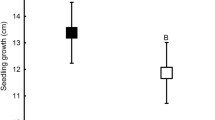Summary
We present results of two experiments designed to identify the relative importance of dispersal distance, seedling density, and light conditions on pathogen-caused mortality of tropical tree seedlings. The field experiment on Barro Colorado Island, Panama, demonstrated that both an increase in dispersal distance and a decrease in seedling density reduce levels of damping-off disease among seedlings of Platypodium elegans, and that there is an interaction between the two factors. The results indicated significant variation among sites in pathogen activity and suggested that seedlings are more vulnerable to disease when establishing around their parent tree than around other conspecific trees.
The second experiment in a screened enclosure used potted seedlings of 18 wind-dispersed tree species exposed to two levels of sunlight and seedling density. The results indicated that environmental conditions similar to those in light-gaps significantly reduce pathogen activity. They also confirmed that high seedling density increases disease levels, especially under shaded conditions.
Seedlings of 16 of the 18 species experienced pathogencaused mortality, but in widely varying amounts. Seed weight was not a good predictor of a species' vulnerability to pathogens. Adult wood density, an indicator of growth rate and successional status, was inversely correlated with a species' vulnerability to pathogens. Fast-growing, colonizing species, whose seedlings require light-gaps, lacked strong resistance to seedling pathogens, relative to slow-growing species able to tolerate shade and escape seedling pathogens. We discuss these results in the context of seed dispersal as a means of escaping from seedling pathogens.
Similar content being viewed by others
References
Augspurger CK (1983a) Seed dispersal by the tropical tree, Platypodium elegans, and the escape of its seedlings from fungal pathogens. J Ecol 71:759–771
Augspurger CK (1983b) Seedling survival among tropical tree species: interactions of dispersal distance, light-gaps, and pathogens. Ecology (in press)
Augspurger CK (1983c) Offspring recruitment around tropical trees: changes in cohort distance with time. Oikos 40:189–196
Augspurger CK (1983d) Light requirements of neotropical tree seedlings: a comparative study of growth and survival. J Ecol (in press)
Baker KF (1946) Observations on some Botrytes diseases in California. Pl Dis Reptr 30:145–155
Bazzaz FA, Pickett STA (1980) Physiological ecology of tropical succession: a comparative review. Ann Rev Ecol Syst 11:287–310
Budowski G (1965) Distribution of tropical American rain forest species in the light of successional processes. Turrialba 15:40–42
Burdon JJ, Chilvers GA (1975) Epidemiology of damping-off disease (Pythium irregulare) in relation to density of Lepidium sativum seedlings. Ann Appl Biol 81:135–143
Burdon JJ, Chilvers GA (1976) Epidemiology, of Pythium-induced damping-off in mixed species seedling stands. Ann Appl Biol 82:233–240
Cates RG, Orians GH (1975) Successional status and the palatability of plants to generalized herbivores. Ecology 56:410–418
Chudnoff M (1979) Tropical timbers of the world. US Forest Products Laboratory, USDA, Madison, Wisconsin, p 831
Coley PD (1980) Effects of leaf age and plant life history patterns on herbivory. Nature 284:545–546
Coley PD (1982) Rates of herbivory on different tropical trees. In: Leigh, EG Jr, Rand AS, Windsor DM (eds) The ecology of a neotropical forest: seasonal rhythms and longer-term changes. Smithsonian Institution Press, Washington, DC
Cowling EB (1978), Agricultural and forest practices that favor epidemics. In: Horsfall JG, Cowling EB (eds) Plant disease, vol II. How disease develops in populations. Academic Press, New York, p 436
Croat TB (1978) Flora of Barro Colorado Island. Stanford University Press, Stanford, California, p 943
Feeny PP (1976) Plant apparency and chemical defense. In: Wallace J, Mansell RL (eds) Biochemical interactions between plants and insects. Recent Advances in Phytochemistry, vol 10. Plenum, New York, pp 1–40
Fienberg SE (1978) The analysis of cross-classified categorical data. MIT Press, Cambridge, Massachusetts, p 151
Garrett SD (1970) Pathogenic root-infecting fungi. Cambridge University Press, Cambridge, p 294
Garwood NC (1983) Seed germination in a seasonal tropical forest in Panama: a community study. Ecol Monogr 53:159–181
Gibson IAS (1965) Sowing density and damping-off in pine seedlings. E Afr Agric J 21:183–188
Grime JP (1966) Shade avoidance and shade tolerance in flowering plants. In: Bainbridge R, Evans GC, Rackham O (eds) Light as an ecological factor. Blackwell, Oxford, England, pp 187–209
Grime JP, Jeffrey DW (1965) Seedling establishment in vertical gradients of sunlight. J Ecol 53:621–642
Horsfall JG, Dimond AE (1957) Interactions of tissue sugar, growth substances, and disease susceptibility. Z Pflanzenkr Pflanzenpathol Pflanzenschutz 64:415–421
Leigh EG Jr, Rand AS, Windsor DM (1982) The ecology of a neotropical forest: seasonal rhythms and longer-term changes. Smithsonian Institution Press, Washington, DC
Ng FSP (1978) Strategies of establishment in Malayan forest trees. In: Tomlinson PB, Zimmerman MH (eds) Tropical trees as living systems. Cambridge University Press, Cambridge, England, pp 129–163
Populer C (1978) Changes in host susceptibility with time. In: Horsfall JG, Cowling EB (eds) Plant disease, vol II. How disease develops in populations. Academic Press, New York, pp 239–262
Rhoades DF, Cates RG (1976) Towards a general theory of plant antiherbivore chemistry. In: Wallace J, Mansell RL (eds) Biochemical interactions between plants and insects. Recent Advances in Phytochemistry, vol 10, Plenum, New York, pp 168–213
Rotem J (1978) Climatic and weather influences on epidemics. In: Horsfall JG, Cowling EB (eds) Plant disease, vol II. How disease develops in populations. Academic Press, New York, pp 317–337
Vaartaja O (1962) The relationship of fungi to survival of shaded tree seedlings. Ecology 43:547–549
Walker JC (1969) Plant pathology. McGraw-Hill, New York, p 819
Weber GF (1973) Bacterial and fungal diseases of plants in the tropics. University of Florida Press, Gainesville, Florida, p 673
Whitmore TC (1975) Tropical rain forests of the Far East. Oxford University Press, Oxford, England, p 278
Williamson GB (1975) Pattern and seral composition in an oldgrowth beech-maple forest. Ecology 56:727–731
Author information
Authors and Affiliations
Rights and permissions
About this article
Cite this article
Augspurger, C.K., Kelly, C.K. Pathogen mortality of tropical tree seedlings: experimental studies of the effects of dispersal distance, seedling density, and light conditions. Oecologia 61, 211–217 (1984). https://doi.org/10.1007/BF00396763
Received:
Issue Date:
DOI: https://doi.org/10.1007/BF00396763




